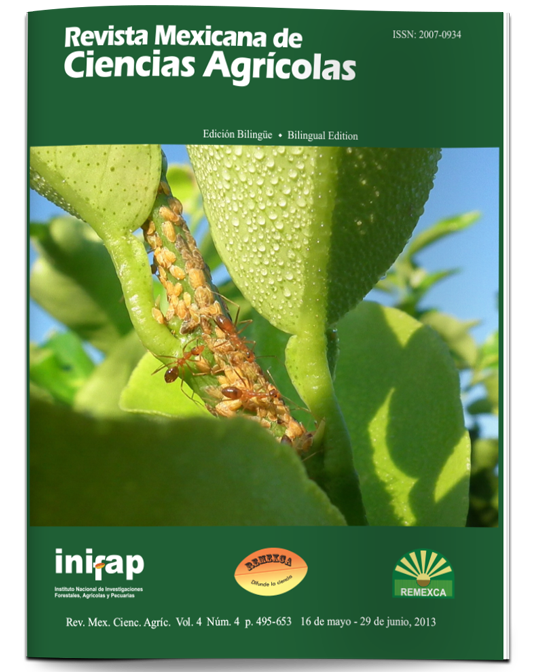Nutrition of potato crop (Solanum tuberosum L.) under climate variability in “Valle del Fuerte”, Sinaloa, Mexico
DOI:
https://doi.org/10.29312/remexca.v4i4.1191Keywords:
growing degree-days, fertilization, self- adjusting functionsAbstract
The traditional management of potato cultivation is becoming less functional due to the high climatic variability in the production areas of northwestern Mexico, which provoke an excessive application of inputs, pollution and low profitability. In order to improve this, we generated a methodology that helps to bind the demand of nutrients to the climate through self-adjusting functions based on the concept of degree-day (°D), derived from the extraction curves. The work was carried out in the north of Sinaloa during two autumn-winter agricultural cycles (AW), 2008- 2009 and 2009-2010, in the INIFAP-CIRNO-CEVAF. In the first cycle we obtained base curves of nutrient extraction (BC) for the Alpha variety under drip irrigation; in the second cycle we validated the BC with the Fianna variety under surface irrigation by an experiment with three treatments (T) in a randomized complete block arrangement. T1 was fertilization with NPK according to BC (245, 30, 350 kg ha-1) while T2 consisted of fertilization using BC+20% (294, 36, 420 kg ha-1) and T3 consisted of BC-20% (196, 24, 280 kg ha-1). Total nutrient extraction was similar in all treatments; however, the absorption rate was different in the initial stages of cultivation. Because the difference at T2 was significant with respect to tuber yield and quality, the mathematical functions were generated from it, obtaining R2 values greater than 0.8. The methodology was successfully tested on two commercial plots.
Downloads
Downloads
Published
How to Cite
Issue
Section
License
The authors who publish in Revista Mexicana de Ciencias Agrícolas accept the following conditions:
In accordance with copyright laws, Revista Mexicana de Ciencias Agrícolas recognizes and respects the authors’ moral right and ownership of property rights which will be transferred to the journal for dissemination in open access. Invariably, all the authors have to sign a letter of transfer of property rights and of originality of the article to Instituto Nacional de Investigaciones Forestales, Agrícolas y Pecuarias (INIFAP) [National Institute of Forestry, Agricultural and Livestock Research]. The author(s) must pay a fee for the reception of articles before proceeding to editorial review.
All the texts published by Revista Mexicana de Ciencias Agrícolas —with no exception— are distributed under a Creative Commons License Attribution-NonCommercial 4.0 International (CC BY-NC 4.0), which allows third parties to use the publication as long as the work’s authorship and its first publication in this journal are mentioned.
The author(s) can enter into independent and additional contractual agreements for the nonexclusive distribution of the version of the article published in Revista Mexicana de Ciencias Agrícolas (for example include it into an institutional repository or publish it in a book) as long as it is clearly and explicitly indicated that the work was published for the first time in Revista Mexicana de Ciencias Agrícolas.
For all the above, the authors shall send the Letter-transfer of Property Rights for the first publication duly filled in and signed by the author(s). This form must be sent as a PDF file to: revista_atm@yahoo.com.mx; cienciasagricola@inifap.gob.mx; remexca2017@gmail.
This work is licensed under a Creative Commons Attribution-Noncommercial 4.0 International license.



